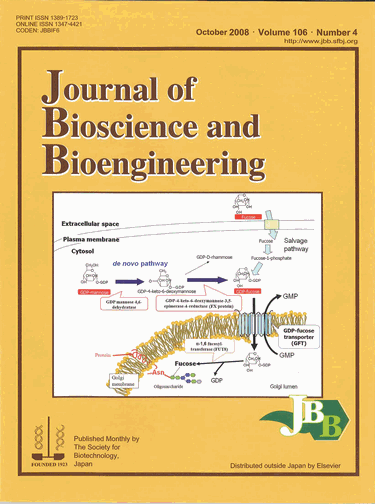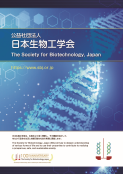Journal of Bioscience and Bioengineering Vol. 106, No. 4 (2008)
Vol. 106, October 2008
Glycosylation is the most extensive of all post-translational modifications and plays an important role in secretion, antigenicity, in vivo function, and the clearance of glycoproteins in blood. Glycosylation control is an important issue for the industrial production of therapeutic proteins. Human antithrombin III (AT-III) is a plasma glycoprotein and is used as a biopharmaceutical for preventing and regulating blood coagulation. The α-1,6 fucosylation of AT-III, which has four N-asparagine glycosylation sites, significantly reduces antithrombin–heparin affinity. Hence, defucosylation is one of the most important issues for quality control of commercial AT-III production using mammalian cell culture.
Figure illustrates the biosynthesis of GDP-fucose and protein fucosylation in a mammalian cell. Cytosol GDP-mannose is converted to GDP-4-keto-6-deoxymannose by GDP-mannose dehydratase (GMD). This intermediate is converted to GDP-fucose by GDP-4-keto-6-deoxymannnose-3,5-epimerase-4-reductase (GMER). GDP-fucose is transported through Golgi membrane by GDP-fucose transporter (GFT). In the Golgi apparatus, fucose is transferred from GDP-fucose to N-linked-type complex glycoprotein by α-1,6 fucosyltransferase (FUT8).
Related article: Omasa, T., Tanaka, R., Doi, T., Ando, M., Kitamoto, Y., Honda, K., Kishimoto, M., and Ohtake, H., “Decrease in antithrombin III fucosylation by expressing GDP-fucose transporter siRNA in Chinese hamster ovary cells“, J. Biosci. Bioeng., vol. 106, 168-173 (2008).
⇒JBBアーカイブ:Vol.107 (2009) ~最新号
⇒JBBアーカイブ:Vol. 93(2002)~Vol. 106(2008)



.gif)